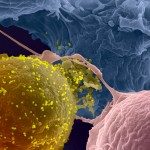Link to Pubmed [PMID] – 25926647
J. Virol. 2015 Jul;89(14):6994-7006
UNLABELLED: Monocyte-derived dendritic cells (MDDC) stimulate CD8 cytotoxic T lymphocytes (CTL) by presenting endogenous and exogenous viral peptides via major histocompatibility complex class I (MHC-I) molecules. MDDC are poorly susceptible to HIV-1, in part due to the presence of SAMHD1, a cellular enzyme that depletes intracellular deoxynucleoside triphosphates (dNTPs) and degrades viral RNA. Vpx, an HIV-2/SIVsm protein absent from HIV-1, antagonizes SAMHD1 by inducing its degradation. The impact of SAMHD1 on the adaptive cellular immune response remains poorly characterized. Here, we asked whether SAMHD1 modulates MHC-I-restricted HIV-1 antigen presentation. Untreated MDDC or MDDC pretreated with Vpx were exposed to HIV-1, and antigen presentation was examined by monitoring the activation of an HIV-1 Gag-specific CTL clone. SAMHD1 depletion strongly enhanced productive infection of MDDC as well as endogenous HIV-1 antigen presentation. Time-lapse microscopy analysis demonstrated that in the absence of SAMHD1, the CTL rapidly killed infected MDDC. We also report that various transmitted/founder (T/F) HIV-1 strains poorly infected MDDC and, as a consequence, did not stimulate CTL. Vesicular stomatitis virus glycoprotein (VSV-G) pseudotyping of T/F alleviated a block in viral entry and induced antigen presentation only in the absence of SAMHD1. Furthermore, by using another CTL clone that mostly recognizes incoming HIV-1 antigens, we demonstrate that SAMHD1 does not influence exogenous viral antigen presentation. Altogether, our results demonstrate that the antiviral activity of SAMHD1 impacts antigen presentation by DC, highlighting the link that exists between restriction factors and adaptive immune responses.
IMPORTANCE: Upon viral infection, DC may present antigens derived from incoming viral material in the absence of productive infection of DC or from newly synthesized viral proteins. In the case of HIV, productive infection of DC is blocked at an early postentry step. This is due to the presence of SAMHD1, a cellular enzyme that depletes intracellular levels of dNTPs and inhibits viral reverse transcription. We show that the depletion of SAMHD1 in DCs strongly stimulates the presentation of viral antigens derived from newly produced viral proteins, leading to the activation of HIV-1-specific cytotoxic T lymphocytes (CTL). We further show in real time that the enhanced activation of CTL leads to killing of infected DCs. Our results indicate that the antiviral activity of SAMHD1 not only impacts HIV replication but also impacts antigen presentation by DC. They highlight the link that exists between restriction factors and adaptive immune responses.
